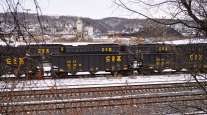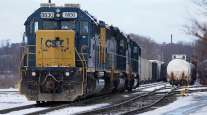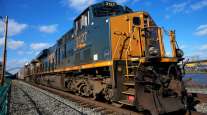Profits Up at CSX, Decline at CP in 1Q; Harrison Pushes for Rail Consolidation

This story appears in the April 24 print edition of Transport Topics.
Rail freight companies began the earnings season with mixed results as profits rose 1.7% at CSX Corp. but plunged 20% at Canadian Pacific Railway Ltd. in the first quarter compared with the same period a year ago.
CSX generated net income of $362 million, or 39 cents per share. Last year, it posted $356 million, or 37 cents, in net income. Revenue at the Jacksonville, Fla.-based rail grew 10% to $2.9 billion versus a year ago.
However, CSX recorded a $173 million one-time restructuring charge, resulting in a 13% year-over-year increase in expenses. Operating income (the difference between revenue and expenses) rose 1% to $712 million.
Newly installed CEO E. Hunter Harrison, 72, didn’t discuss first-quarter results because he hadn’t been at the helm for a significant portion of that period. Harrison left rival Canadian Pacific in January and joined CSX in March.
“[Never] did I think that I would finish [my career] in Jacksonville with a group of railroaders with the talent that they possess and the franchise that’s before us. I’m very excited about the opportunities,” he said on a conference call. “This franchise, if you apply it to my career, to some degree, has more potential than anyone I’ve dealt with.”
Meanwhile, his former employer in Calgary, Alberta, reported a sharp decline for the quarter.
Canadian Pacific earned C$431 million, or $2.93, compared with $540 million, or $3.51, in the year-ago period. Revenue increased 1% to $1.6 billion.
“We actually had a win this year, a much more challenging operating environment versus last year, which provided some headwinds relative to service, relative to cost, as well as, I would say, revenue as well,” Keith Creel, CEO of CP, said on a conference call.
Industry analysts have speculated that Harrison might pursue a merger or acquisition with his old company after implementing the precision scheduled railroading concept at CSX, which prioritizes productivity, on-time service and simplifying operations. Creel was part of Harrison’s team at CP that instilled the same principles.
While Creel wouldn’t discuss any merger and acquisition activity with CSX, he said CP is prepared to work with any railroad if it improves bottom-line results.
“Our single largest interchange carrier in Chicago is the CSX. We said that before. It’s a matter of public record. And all that traffic goes to belt currently today. So from an operational standpoint, I would have to think there’s got to be some synergies, some opportunities that would give asset terms and premium as well as customer experience, be it CP-originated or CSX- terminated or vice-versa,” Creel said.
Harrison didn’t address the issue, either, but he made a pitch for consolidation within the industry.
“We go to L.A. to a customer and talk about providing service to New York, and I’ll talk to you about half of it. They don’t want to hear about half of it; they want to hear about all of it. And until one entity controls movement, rail is never going to have the competitive alternative to the highway,” he said.
Revenue from intermodal services improved at both companies, another sign that the segment could be on the upswing after a difficult 2016.
CSX intermodal revenue rose 7% to $434 million, while CP’s grew 5% to $325 million.
Volume was up about 1% at CSX to 688,000 carloads and flat for CP at 233,000. Revenue per carload went up 6% at CSX and 5% at CP.
Domestic intermodal volumes fell 1% at CSX, but international truck-rail freight increased 5%.
CP doesn’t separate intermodal totals based on domestic and international intermodal.
Mineral transportation was the most profitable for CSX in the first quarter with volume and revenue up 21% to $114 million. Coal, which has been a drag on results for the railroads in recent years, improved 1% in volume and 31% in revenue to $522 million.
CSX’s operating ratio deteriorated 201 basis points to 75.2%, although when the one-time restructuring expenses were removed, the ratio improves 390 basis points to 69.2%.
CP’s ratio improved 80 basis points to 58.1%, although when management costs related to the Harrison departure were included with other adjustments, it deteriorated 240 basis points to 61.3%.




